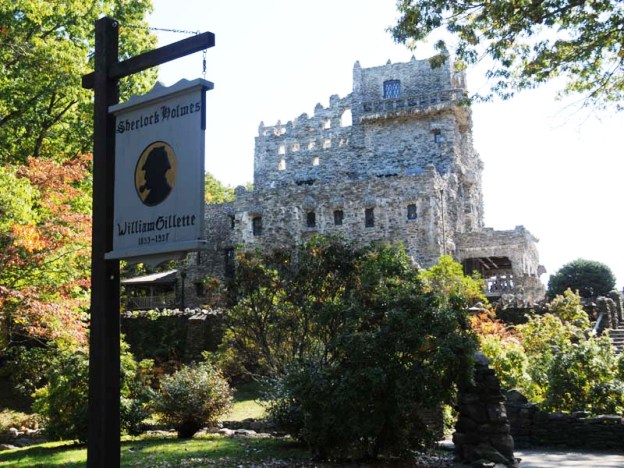High on the hill overlooking the beautiful Connecticut River between Lyme and Haddam is the site of one of the most unique castles constructed as private residences in New England during the late 1880’s and early 1900’s. Gillette Castle was designed and built between 1914 and 1919 by William Gillette, an actor who gained fame and fortune for his early stage portrayals of Sherlock Holmes at the turn of the century.

Gillette was born to a prominent Hartford family in 1854 and was bitten by the acting bug in his teens. Although his parents would have preferred a more traditional career, his renown grew as an actor and he achieved considerable success. What took his career to its greatest heights at age forty-five was when he adopted Sir Arthur Conan Doyle’s Sherlock Homes writing to the stage, and in 1899 traveled to England to present his script to Doyle seeking approval.
Gillette met him at the train station disguised as Sherlock Homes and approached Doyle slowly saying, “You’re the writer, no doubt about it.” They hit it off immediately, Doyle liked the script and the two became close lifelong friends. With Doyle’s approval and blessings, Gillette added many of the most distinctive details we have come to associate with the Sherlock Homes character such as the deerstalker cap, the Inverness cape and pipe. He actually was the origin of what would become Sherlock Homes’ most remembered line, “This is elementary, my dear Watson.”
With this character portrayal, William Gillette became one of the most popular American actors of his day playing Sherlock Homes over 1,000 times and earning him over $300,000 a year which was a huge income at the time. In 1913 at fifty-nine, after acquiring a tidy fortune Gillette was sailing up the Connecticut River on his houseboat, Aunt Polly, and spotted high on the east bank a hill which is the southernmost of the Seven Sisters ridgeline. He moored his boat, climbed the hill, and was so taken by the views and open space that he purchased the land almost immediately.
Over the next five years – and a million dollars later – he designed and built his fieldstone twenty four room luxury mansion that used wood and stone in extraordinarily creative and amazing ways. William Gillette lived in his houseboat moored at the river and transported building materials up the steep hill from the river to the hilltop building site with an elaborate aerial trolley he designed.
Built in a style reminiscent of a medieval castle the exterior walls have an outline and texture that contributes to the odd and eccentric character of the mansion that Gillette truly relished. He never referred to it as a castle, but rather as “The Seventh Sister.” The ivy covered fieldstone walls taper from five feet thick at the base to three feet in the upper stories.
The castle is riddled with Gillette’s penchant for exotic detail and eccentricities such as forty seven intricately crafted doors, door knobs and hand carved wooden sliding puzzle locks – no two of which are the same. The dining room had a dining table that could vanish into the wall. The castle had a disappearing bar that was used during Prohibition that could open or close quickly if you knew the right combination. The woodwork within the castle is hand-hewn southern white oak and the mansion’s beautiful luxury furnishings were the finest from around the world.
A complex system of hidden mirrors for surveillance of the public rooms from his master bedroom was created by Gillette, saying this was how he could see guests arriving and “make a great entrance in the opportune moment.” Gillette was also a train enthusiast and constructed a three mile miniature railway on the property powered by two locomotives that he loved taking guests on a tour of his home over trestles and through a tunnel around the estate. The hiking trails Gillette designed had stone-arch bridges, vertical steps and a goldfish pond.
Gillette died in 1937 at eighty-three. He left no heirs and made very clear in his will that he would prefer his home be sold at a loss than “End up in the hands of some blithering saphead” who didn’t appreciate its value. The State of Connecticut bought the property in 1943 and has made it one of the area’s finest parks open to the public with campgrounds, hiking trails, fishing and picnic spots.
The Castle located at 67 River Rd., Hadlyme, Connecticut is open from 10 a.m. to 4:30 p.m., Memorial Day weekend through Columbus Day. You can also take the Chester – Hadlyme ferry across the Connecticut River from Chester to get to Gillette Castle.
It’s a hike from the river to the hilltop, but the approach on the ferry gives you the best view of the Castle in all its glory sitting high on “The Seventh Sister.” The sweeping views of the Connecticut River estuary makes it almost worth the trip alone. The estate was added to the National Register of Historic Places in 1986 and William Gillette’s mansion receives about 300,000 visitors annually making it one of Connecticut’s most important historic luxury homes.

